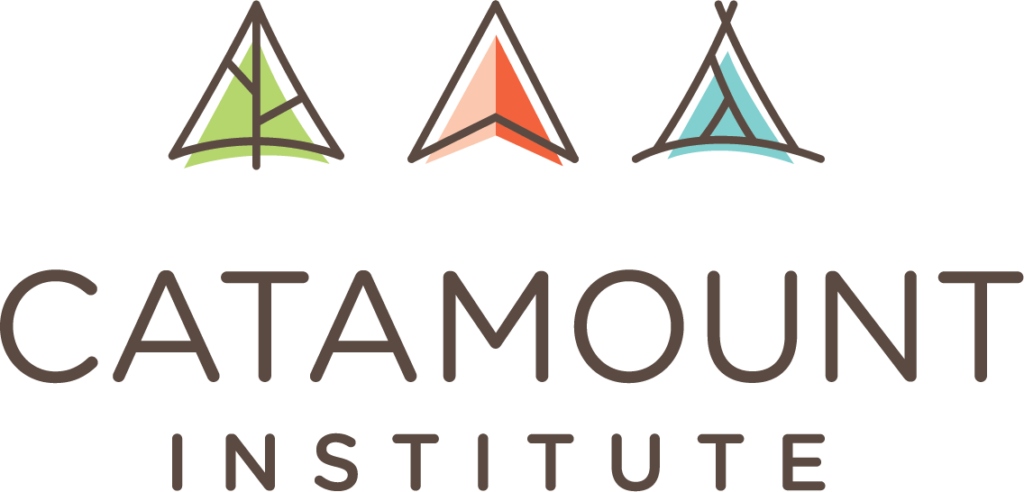Invest in future Generations
Giving Basics
There are many ways you can give to Catamount Institute. Planned giving, IRA’s, QCD, donor-advised fund, what do these all mean? Read on to learn more. The following is for informational purposes only and not financial advice. Meet with a tax professional or financial advisor to make a plan that is best for your situation.
Gifting Strategies
A gift of life insurance enables you to donate more than you might currently have available and results in a larger future gift to the charitable organization. If the charity is named as owner and beneficiary of the policy, you can receive an income tax deduction for the premiums you pay within certain limits.
With a charitable lead trust, you place money or income-producing assets in the trust. The charitable organization receives regular payments from the trust for the duration of the trust. At the end of the trust period, the remaining assets are paid to you or your heirs. This can help reduce, or in some cases even eliminate, estate taxes on appreciated assets that are eventually transferred to your heirs.
Using a charitable remainder trust, you donate property to the trust. You receive regular payments from the trust for a specific number of years or your lifetime. You are generally taxed on distributions to you from the trust. At the end of the trust period, the remaining assets are paid to the charitable organization. You may also qualify for a current income tax deduction on the estimated present value of the remainder interest to go to charity eventually. And even though you cannot take your gift back once it’s in the trust, you can change the charity that will eventually receive your gift.
A private family foundation is a separate legal entity that can endure for many generations after your death. You create the foundation, then transfer assets to the foundation, which makes grants to public charities. You and your descendants have complete control over which charities receive grants. But, unless you can contribute enough capital to generate funds for grants, the costs and complexities of a private foundation may not be worth it.
A general guideline is that you should be able to donate enough assets to generate at least $25,000 a year for grants.
If you want your dollars to be spent on improving the quality of life in a particular community, consider giving to a community foundation. Like a private foundation, a community foundation accepts donations from many sources and is overseen by individuals familiar with the community’s particular needs and skilled at running a charitable organization.
Similar in some respects to a private foundation, a donor-advised fund offers an easier way for you to make a significant gift to charity over a long period of time. A donor-advised fund actually refers to an account that is held within a charitable organization. The charitable organization is a separate legal entity, but your account is not merely a component of the charitable organization that holds the account. Once you transfer assets to the account, the charitable organization becomes the legal owner of the assets and has ultimate control over them. You can only advise — not direct — the charitable organization on how your contributions will be distributed to other charities.
Using your IRA to Give
Did you know that if you are at least 70½ years old, you can make tax-free charitable donations directly from your IRA? By making what’s called a qualified charitable distribution (QCD), you can benefit your favorite charity while excluding up to $100,000 annually from gross income. These gifts, also known as “charitable IRA rollovers,” would otherwise be taxable IRA distributions.1
How QCDs work
To make a QCD, you instruct your IRA trustee to make a distribution directly from your IRA (other than SEP and SIMPLE IRAs) to a qualified charity. The distribution must be one that would otherwise be taxable to you. You can exclude up to $100,000 of QCDs from your gross income each year. And if you file a joint return, your spouse (if 70½ or older) can exclude an additional $100,000 of QCDs. Note: You don’t get to deduct QCDs as a charitable contribution on your federal income tax return — that would be double-dipping.
QCDs count toward satisfying any required minimum distributions (RMDs) that you would otherwise have to receive from your IRA, just as if you had received an actual distribution from the plan. However, distributions that you actually receive from your IRA (including RMDs) and subsequently transfer to a charity cannot qualify as QCDs.
As indicated earlier, a QCD must be an otherwise taxable distribution from your IRA. If you’ve made nondeductible contributions, then normally, each distribution carries with it a pro-rata amount of taxable and nontaxable dollars. However, a special rule applies to QCDs — the pro-rata rule is ignored, and your taxable dollars are treated as distributed first.
If you have multiple IRAs, they are aggregated when calculating the taxable and nontaxable portion of a distribution from any one IRA.
RMDs are calculated separately for each traditional IRA you own but may be taken from any of your IRAs.
Your QCD cannot be made to a private foundation, donor-advised fund, or supporting organization [as described in IRC Section 509(a)(3)]. Further, the gift cannot be made in exchange for a charitable gift annuity or a charitable remainder trust.
Why are QCDs important?
Without this special rule, taking a distribution from your IRA and donating the proceeds to a charity would be a bit more cumbersome and possibly more expensive. You would request a distribution from the IRA and then contribute to the charity yourself. You’d include the distribution in gross income and then take a corresponding income tax deduction for the charitable contribution. But due to IRS limits, the additional tax from the distribution may be more than the charitable deduction. And due to much higher standard deduction amounts ushered in by the Tax Cuts and Jobs Act passed in 2017, itemizing deductions may have become even less beneficial in 2018 and beyond, rendering QCDs even more potentially appealing.
QCDs avoid all this by providing an exclusion from income for the amount paid directly from your IRA to the charity — you don’t report the IRA distribution in your gross income, and you don’t take a deduction for the QCD.
Can I name a charity as the beneficiary of my IRA?
Yes, you can name a charity as the beneficiary of your IRA, but be sure to understand the advantages and disadvantages.
Generally, a spouse, child, or another individual you designate as beneficiary of a traditional IRA must pay federal income tax on any distribution received from the IRA after your death. By contrast, if you name a charity as beneficiary, the charity will not have to pay any income tax on distributions from the IRA after your death (provided that the charity qualifies as a tax-exempt charitable organization under federal law), a significant tax advantage.
After your death, distributions of your assets to a charity generally qualify for an estate tax charitable deduction. In other words, if a charity is your sole IRA beneficiary, the full value of your IRA will be deducted from your taxable estate for purposes of determining the federal estate tax (if any) that may be due. This can also be a significant advantage if you expect the value of your taxable estate to be at or above the federal estate tax exclusion amount ($11,700,000 for 2021).
Of course, there are also nontax implications. If you name a charity as the sole beneficiary of your IRA, your family members and other loved ones will obviously not receive any benefit from those IRA assets when you die. If you would like to leave some of your assets to your loved ones and some assets to charity, consider leaving your taxable retirement funds to charity and other assets to your loved ones. This may offer the most tax-efficient solution because the charity will not have to pay any tax on the retirement funds.
If retirement funds are a major portion of your assets, another option to consider is a charitable remainder trust (CRT). A CRT can be structured to receive the funds free of income tax at your death and then pay a (taxable) lifetime income to individuals of your choice. When those individuals die, the remaining trust assets pass to the charity. Finally, another option is to name the charity and one or more individuals as co-beneficiaries. (Note: There are fees and expenses associated with the creation of trusts.)
Also, with the recent changes to the rules around inheriting IRAs by non-spousal beneficiaries, unique strategies are combining the use of insurance to provide an inheritance to your beneficiaries still and leave your IRA balance to a charity.
The legal and tax issues discussed here can be complex. Be sure to consult a financial advisor, tax specialist, and/or estate planning attorney for further guidance.
Unique to recent law changes and residents of Colorado
On Sunday, December 27, 2020, the Consolidated Appropriations Act, 2021 (CAA 2021) was signed into law. A $900 billion emergency relief package is included as part of this omnibus spending bill. It is intended to assist individuals and businesses during the ongoing coronavirus pandemic and accompanying economic crisis. Some of the charitable giving relief aspects were:
- Enhancements to the normal charitable gifts deduction rules in 2020 have been extended through 2021.
- For those who itemize deductions, the limit on the charitable gifts deduction has been increased to 100% of AGI for direct cash gifts to public charities.
- For nonitemizers, a $300 (increased to $600 in 2021 for joint returns) charitable deduction for direct cash gifts to public charities is available (in addition to the standard deduction).
Coloradans can give all or part of their state income tax refund directly to one of more than 7,750 eligible nonprofits registered with the state.
Through the Donate to a Colorado Nonprofit program, taxpayers can choose to directly support an eligible Colorado-registered charity with a simple designation on their state income tax return. The Donate to a Colorado Nonprofit program is being promoted through an educational campaign called ReFUND CO.
In Summary
Giving strategically can benefit both you and the charitable organization you choose and could potentially benefit your heirs. A properly planned gift might enable you to realign your investment portfolio, help diversify your holdings, increase your cash flow — and help leave a greater legacy.
Whatever gifting strategy you choose, planned giving can be very rewarding. It’s wonderful to see your gift at work and to receive tax benefits as well.
While trusts offer numerous advantages, they incur up-front costs and ongoing administrative fees. The use of trusts involves a complex web of tax rules and regulations. You might consider enlisting the counsel of an experienced estate planning professional and your legal and tax advisors before implementing such strategies.
Thank you for your previous and future gifts. Enjoy gathering those receipts for tax season, and have a wonderful summer!
1Beginning after 2019, if you make deductible contributions to an IRA for the year you reach age 70½ or beyond, this could reduce the allowable amount of your QCD.
2Legislation passed at the end of 2019 raised the RMD age to 72 (from age 70½) beginning January 1, 2020. If you reach age 72 before July 1, 2021, you will need to take an RMD by December 31, 2021.

